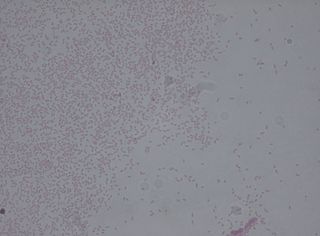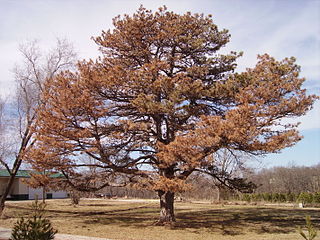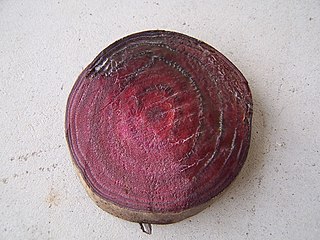Blight is a specific symptom affecting plants in response to infection by a pathogenic organism.

Fire blight, also written fireblight, is a contagious disease affecting apples, pears, and some other members of the family Rosaceae. It is a serious concern to apple and pear producers. Under optimal conditions, it can destroy an entire orchard in a single growing season.

Stewart's wilt is a bacterial disease of corn caused by the bacterium Pantoea stewartii. The disease is also known as bacterial wilt or bacterial leaf blight and has been shown to be quite problematic in sweet corn. The causal organism is a facultatively anaerobic, gram-negative, rod-shaped bacterium. The disease is endemic in the mid-Atlantic and Ohio River Valley regions and in the southern portion of the Corn Belt. Stewart's Wilt causes minor reductions in field corn yield, despite common occurrence, because most hybrids grown in the Midwest have adequate resistance. However, the disease can be problematic in seed production because many countries have restrictions on maize seed from areas where the Stewart's Wilt occurs.

Dickeya dadantii is a Gram-negative bacillus that belongs to the family Pectobacteriaceae. It was formerly known as Erwinia chrysanthemi but was reassigned as Dickeya dadantii in 2005. Members of this family are facultative anaerobes, able to ferment sugars to lactic acid, have nitrate reductase, but lack oxidases. Even though many clinical pathogens are part of the order Enterobacterales, most members of this family are plant pathogens. D. dadantii is a motile, non-sporing, straight rod-shaped cell with rounded ends, much like the other members of the genus, Dickeya. Cells range in size from 0.8 to 3.2 μm by 0.5 to 0.8 μm and are surrounded by numerous flagella (peritrichous).

Black rot is a name used for various diseases of cultivated plants caused by fungi or bacteria, producing dark brown discoloration and decay in the leaves of fruit and vegetables:
Antagonism occurs when one organism inhibits or slows down the growth of a plant disease-causing organism, such as harmful bacteria or fungi. Most plants can host a variety of pathogens and are often infected by multiple species simultaneously. In ecology, species competing for the same resource can influence each other in two ways: antagonism, where one pathogen harms another, and synergism, where one pathogen supports the growth of another.

Pseudomonas viridiflava is a fluorescent, Gram-negative, soil bacterium that is pathogenic to plants. It was originally isolated from the dwarf or runner bean, in Switzerland. Based on 16S rRNA analysis, P. viridiflava has been placed in the P. syringae group. Following ribotypical analysis misidentified strains of Pseudomonas syringae pv. ribicola and Pseudomonas syringae pv. primulae were incorporated into this species. This pathogen causes bacterial blight of Kiwifruit.

Pantoea agglomerans is a Gram-negative bacterium that belongs to the family Erwiniaceae.
Curtobacterium flaccumfaciens is a Gram-positive bacterium that causes disease on a variety of plants. Gram-positive bacteria characteristics include small irregular rods, lateral flagella, the ability to persist in aerobic environments, and cells containing catalase. In the interest of studying pathogenicity in plants, this species is broken down further into pathovars, which help to better describe the pathogen.

Pectobacterium carotovorum is a bacterium of the family Pectobacteriaceae; it used to be a member of the genus Erwinia.

Bacterial wilt is a complex of diseases that occur in plants such as Cucurbitaceae and Solanaceae and are caused by the pathogens Erwinia tracheiphila, a gram-negative bacterium, or Curtobacterium flaccumfaciens pv. flaccumfaciens, a gram-positive bacterium. Cucumber and melon plants are most susceptible, but squash, pumpkins, and gourds may also become infected.

A wilt disease is any number of diseases that affect the vascular system of plants. Attacks by fungi, bacteria, and nematodes can cause rapid killing of plants, large tree branches or even entire trees.

Dickeya solani is a bacterium that causes blackleg and soft rot in potato crops. Its symptoms are often indistinguishable from those caused by Pectobacterium but is more virulent, causing disease from lower levels of inoculum and spreading through the plant more effectively.
Erwinia pyrifoliae is a Gram-negative bacterium and a phytopathogen of Asian pear trees, causing necrotic disease. Its type strain is Ep16/96T(=CFBP 4172T =DSM 12163T.

Beet vascular necrosis and rot is a soft rot disease caused by the bacterium Pectobacterium carotovorum subsp. betavasculorum, which has also been known as Pectobacterium betavasculorum and Erwinia carotovora subsp. betavasculorum. It was classified in the genus Erwinia until genetic evidence suggested that it belongs to its own group; however, the name Erwinia is still in use. As such, the disease is sometimes called Erwinia rot today. It is a very destructive disease that has been reported across the United States as well as in Egypt. Symptoms include wilting and black streaks on the leaves and petioles. It is usually not fatal to the plant, but in severe cases the beets will become hollowed and unmarketable. The bacteria is a generalist species which rots beets and other plants by secreting digestive enzymes that break down the cell wall and parenchyma tissues. The bacteria thrive in warm and wet conditions, but cannot survive long in fallow soil. However, it is able to persist for long periods of time in the rhizosphere of weeds and non-host crops. While it is difficult to eradicate, there are cultural practices that can be used to control the spread of the disease, such as avoiding injury to the plants and reducing or eliminating application of nitrogen fertilizer.
Plant pathology has developed from antiquity, but scientific study began in the Early modern period and developed in the 19th century.

Collar rot is a symptomatically described disease that is usually caused by any one of various fungal and oomycete plant pathogens. It is present where the pathogen causes a lesion localized at or about the collet between the stem and the root. The lesions develop around the stem eventually forming a "collar". Observationally, collar rot grades into "basal stem rot", and with some pathogens is the first phase of "basal stem rot" often followed by "root rot". Collar rot is most often observed in seedings grown in infected soil. The pathogens that cause collar rot may be species or genera specific. But generalist pathogens such as Agroathelia rolfsii are known to attack over 200 different species. While bacteria caused collar rot is not common, trees infected with Fire blight may develop collar rot. Non-parasitic collar rot may be caused by winter damage.
Robert S. Dickey was an American phytopathologist, professor emeritus of Plant Pathology at the Cornell University and the namesake of the bacterial genus Dickeya.
Xanthomonas campestris pv. juglandis is an anaerobic, Gram negative, rod-shaped bacteria that can affect walnut trees though the flowers, buds, shoots, branches, trunk, and fruit. It can have devastating effects including premature fruit drop and lesions on the plant. This pathogen was first isolated by Newton B. Pierce in California in 1896 and was then named Pseudomonas juglandis. In 1905 it was reclassified as Bacterium juglandis, in 1930 it became Phytomas juglandis, and in 1939 it was named Xanthomas juglandis. The International Standards for Naming Pathovars declared it to be named Xanthomonas campestris pv. juglandis in 1980. There have been recent proposals to change the name once again to Xanthomonas arboricola pv. juglandis, but this has not yet been universally accepted.
Eve Billing (1923–2019) was a UK plant pathologist specialising in diseases of fruit trees especially fire blight caused by Erwinia amylovora bacteria. She introduced a modelling system to predict the likelihood of outbreaks of fire blight and also methods for pathogen identification and treatment.












